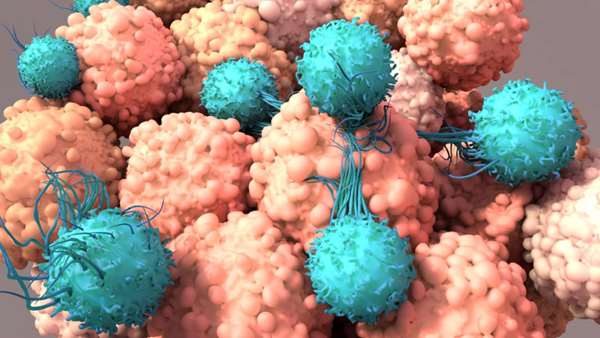A new cancer immunotherapy approach devised by Mayo Clinic researchers combines chimeric antigen receptor (CAR) T-cell therapy with a cancer-killing virus. In animal models, the dual therapy, in the form of a virus-loaded CAR T cell, has been shown to target and treat solid cancer tumors more effectively than either the CAR T-cell therapy or the virus alone, or indeed, the CAR T-cell therapy and the virus administered sequentially.
Details about the new approach appeared in Science Translational Medicine, in an article titled, “Oncolytic virus–mediated expansion of dual-specific CAR T cells improves efficacy against solid tumors in mice.” The article indicates that virus-loaded CAR T cells can transfer and release an oncolytic virus in the vicinity of tumor cells, and that tumor cells subsequently become infected, suffer viral replication, and burst open. This sequence of events leads to a potent immune response.
“We show in an immunocompetent mouse model that coadministration of an oncolytic virus (OV) with CAR T cells expands dual-specific (DS) CAR T cells through presentation of viral antigens through their T-cell receptor (TCR),” the article’s authors wrote. “[This approach confers] a potent proliferative advantage, distinct memory phenotypes, and superior efficacy compared to virus alone or to CAR T cells without OV-mediated TCR stimulation.”
The article’s senior author is Richard Vile, PhD, co-leader of the gene and virus therapy program within Mayo Clinic Cancer Center. Earlier work performed by Vile’s team used vesicular stomatitis virus and reovirus in immunocompetent mice to show that pretreating tumors with oncolytic virus can induce both helpful and deleterious consequences for CAR T cells. In this work, T-cell-tropic chemokines were induced in infected tumors, and CAR T cells underwent attrition due to type I interferon–induced apoptosis in the virus-inflamed tumor.
To avoid the deleterious attrition, Vile’s team decided that the new study would try an alternative strategy: coadministration of the oncolytic virus with the CAR T cells. This strategy would allow the investigators to avoid direct intratumoral delivery of virus, which is not always possible, and to instead exploit improved delivery of the oncolytic virus through a systemic route.
Taking this approach produced encouraging results:
prolonged survival of mice with subcutaneous melanoma and intracranial glioma tumors.
“This approach allows the tumor to be killed by the virus as well as by the CAR T cells,” Vile stated. “In addition, when the virus is delivered, it turns the tumor into a very inflammatory environment, which the patient’s own immune system then sees and starts to attack.”
The therapeutic strategy addresses two major challenges that make solid tumors difficult to treat with CAR T-cell therapy alone. First, the oncolytic virus can break down the molecular shield that some solid tumors use to avoid an immune system attack. Second, the virus can invade the core of the cancer cells—a near-impossible feat for immune cells alone, which often lose their power in the attempt.
“By putting the virus onto the CAR T cell, we activate them against both the virus and the tumor, and they acquire immunological memory,” Vile added. “This allows us to give a boost with the virus at a later time point, which in turn makes the CAR T cells wake up again and undergo additional rounds of killing the tumor.”
Vile and his team found that the combination therapy led to high cure rates in tumors in multiple sites without causing significant toxicity. They also found it resulted in apparent protection in the cured mice against tumor recurrence.
“Clinically, delivering the therapy systemically is a potential advantage because you could possibly treat patients with metastatic disease without having to inject each tumor,” Vile noted.
Vile indicated that he and his team recognize that results from animal models of cancer do not always translate into patient care. “Nonetheless,” he continues, “we are hopeful that we will be able to take this strategy into clinical trials within a year or two. By doing such trials at Mayo Clinic, it will be possible to see if we can add a further level of efficacy of CAR T-cell therapy to the treatment of solid tumors of different types.”
https://www.genengnews.com/topics/translational-medicine/car-t-cells-loaded-with-oncolytic-viruses-boost-attack-on-solid-tumors/




ارسال به دوستان